
The Jibe2 experiment - revisited
Updated August 3rd, 2020
Contents
- The experiment
- Analyses with xflr5 v4 - 2008
- Analyses with flow5 v7.01 beta 12
- Lateral predictions with flow5 v7.01 beta 13
- Conclusions and recommendations
Back to table of contents
The experiment
Back in 2008, Matthieu Scherrer had the opportunity to conduct wind tunnel testing on a small RC racer plane with a wingspan=1370mm.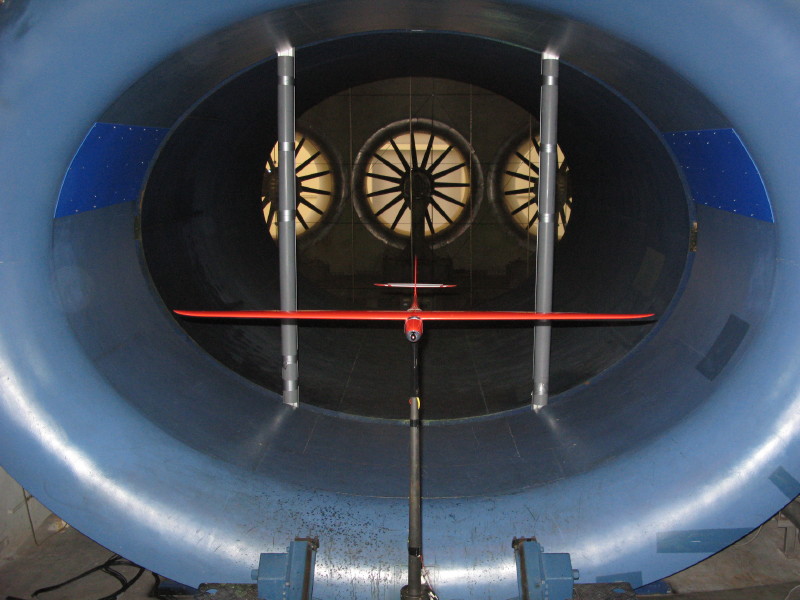
Note: all images are reproduced here with absolutely no permission from Matthieu whatsoever.
The following links provide details of the experiment:
- A video summarizing the experiment can be viewed here: The Jibe 2 experiment (Beware of the unfortunate terrible loud music)
- The full story is on Matthieu's blog: Model aerodynamic prediction workshop
- Matthieu proposed to people who had analysis tools available to make blind predictions which he then compared to his measurements: Results from the Wind Tunnel
Back to top
Analyses with xflr5 v4 - 2008
At the time, predictions were made with xflr5 v4 with mixed results. The test airplane is a difficult test case for xflr5 due to:- The very small tip chords which imply that local Re numbers are small and that the viscous data is difficult to interpolate in the XFoil polars.
- The low camber, low thickness wing airfoil creates low lift, making viscous interpolation difficult.
- The elevator and wing are close in the vertical direction, which creates interference between the wing's wake panels and the elevator.
- The elevator and fin intersect which is not a configuration easily handled by xflr5.
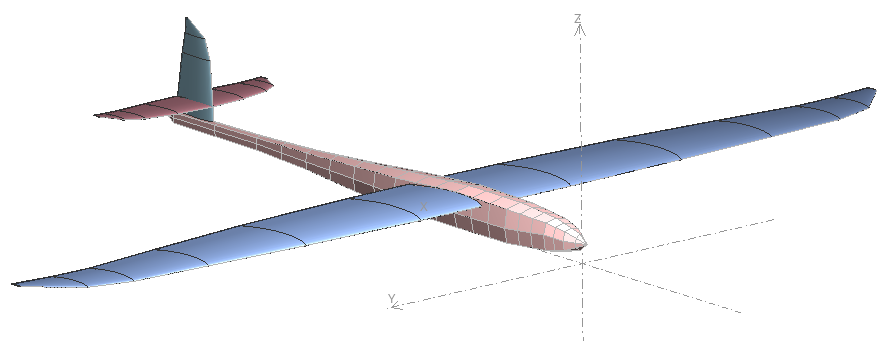
The Jibe2 model in xflr5 v4. Although the body was modeled, it was and still is improperly taken into account in xflr5 due to the lack of connection of the fuselage and wing meshes.
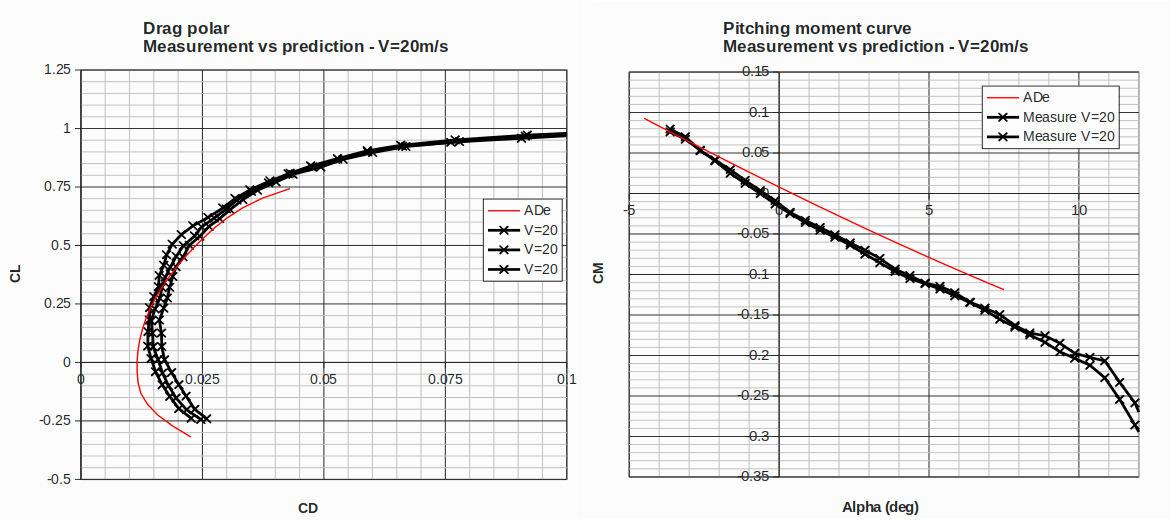
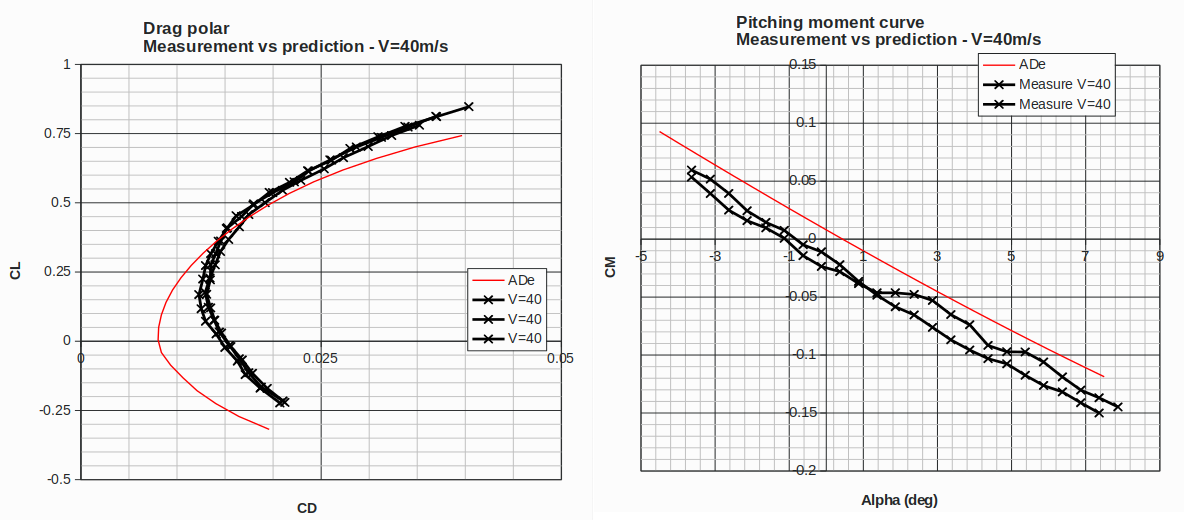
With a more rigorous implementation of the modeling of the fuselage now available in flow5 and with the introduction of the Vortex Particle Wake in flow5 beta12, it seemed worthwhile to revisit this experiment.
Back to top
Analyses with flow5 v7.01 beta 12
The model
Analyses were carried out for a model with and without a fuselage in different configurations:- Flat wake panels with and without the viscous loop,
- Vortex Particle Wake (VPW) with and without the viscous loop.
The tip chords have been increased slightly to improve the interpolation process of viscous data.
All analyses were performed using the triangular panels with uniform densities. As explained elsewhere, the use of the linear method does not bring any significant benefit but increases the computations times by a huge factor.
In the case of the analyses with the VPW, the vortons' core size was set to 100mm and the wake was extended 30 MAC downstream.
All analyses were performed using the triangular panels with uniform densities. As explained elsewhere, the use of the linear method does not bring any significant benefit but increases the computations times by a huge factor.
In the case of the analyses with the VPW, the vortons' core size was set to 100mm and the wake was extended 30 MAC downstream.
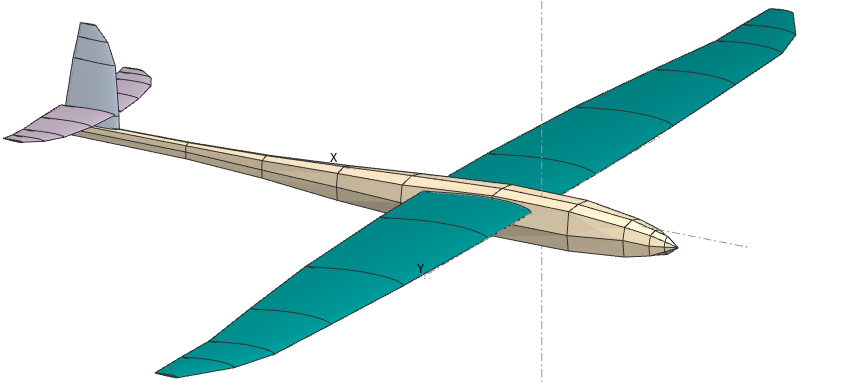
Model without the fuselage

Comparisons at v=20 m/s
Predictions are reasonably accurate whatever the method used, with an underestimation of the total drag mainly due to the absence of the fuselage in the model. Another reason for the difference of drag between prediction and experiment could be linked to the quality of the airflow in the wind tunnel which was not specified. XFoil viscous data was obtained with NCrit=9.
The use of the VPW reduces the induced drag and increases the lift slightly.
Comparisons at v=40 m/s
Model with the fuselage

The Jibe2 model with the rolled-up vortex particle wake.
Comparisons at v=20 m/s
The main points to be noted are:
- The drag predicted with the VPW is noticeably less than in the other cases.
- The pitching moment is not reliable in the case of the flat panel wake. In the case of the T6 analysis, the intersection of the wing's wake panels with the elevator at a.o.a. between 0° and 2° jeopardizes the results. This can be seen in the picture below, where the wake panels shed by the main wing interact with the elevator's panels.
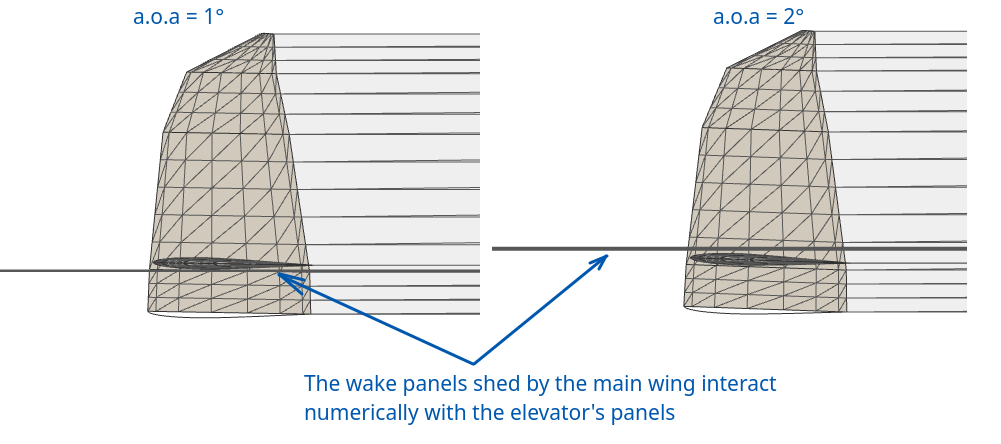
- The use of the VPW solves the problem of wake panel interactions and produces a much more reliable value of the pitching moment whatever the a.o.a.
Comparisons at v=40 m/s
The conclusions are identical to those made at v=20m/s.
The fifth and last polar was run with both the VPW and the viscous loops activated. It improves the prediction of drag compared to the VPW alone, and overpredicts the lift slightly.
Back to topLateral predictions with flow5 v7.01 beta 13
Preliminary considerations
- The comparisons have been run only for the model with the fuselage because of its importance in lateral behaviour.
- Starting in v7.01 beta 13, calcuations in T6 analyses are made in stabiity axes, i.e. with the model rotated by the aoa around the y-axis.
- In the analyses, sideslip is applied as a modification of the wind direction.
- The measured rolling and yawing moments coefficients were normalized using the MAC as the reference length, whereas flow5 uses the span length for these coeffcients. All results presented hereafter have been normalized using the span length.
- The vertical position of the reference point for the moments used in the experiment could not be found. This vertical position was set to the height of the wing in the predictions. This may impact the predicted rolling moments.
Results at a.o.a. = 2°
Results at a.o.a. = 6°
The main points to be noted are:
- The predictions of the side force coefficient CY are reliable whatever the analysis method, even in the case of the analyses with the flat panel wake. This is because the side forces are not evaluated by summation of the panel forces but by application of the Kutta-Joukowski theorem to the strip circulations.
- The yawing moment coefficient Cl is very sensitive to the viscosity. This can be seen by the difference of measured results at 20 and 40 m/s. Also worth noting is that the measurements at negative and positive values of the sideslip angle are not quite symmetric.
- The measured yawing moment if not quite zero for beta=0° as it should be. The slopes of the predicted and measured curves are very close. The predictions of the T6 polars with the flat panel wake are not reliable for the reasons explained above.
- The analyses with the VPW are both robust, i.e. not too sensitive to analysis settings, and reliable, i.e. their predictions are close to the measurements.
In the case of the rolling moment Cl, the predictions turn out to be an approximate average of the measurements made at 20 m/s and 40 m/s.
Conclusions and recommendations
The VPW is a new and relatively untested feature, so more numerical testing and benchmarking needs to be performed before firm conclusions can be drawn. That being said, the comparison to the Jibe2 experimental results seems to show a few trends.- Given the drastic simplifying assumptions made in the potential flow solution, predictions are unexpectedly reliable.
- The drag is under-predicted whenever the fuselage is not included in the analysis. However, all things being equal, numerical simulations without the fuselage have the advantage of being fast and can be used to compare solutions before moving on to more accurate but also more complex and lengthy analyses.
- The VPW should be preferred to the flat wake panel representation whenever the fuselage is included in the model, especially for the calculation of the moments.
- All things being equal, it seems less important to include the viscous loop than the VPW in the analyses.